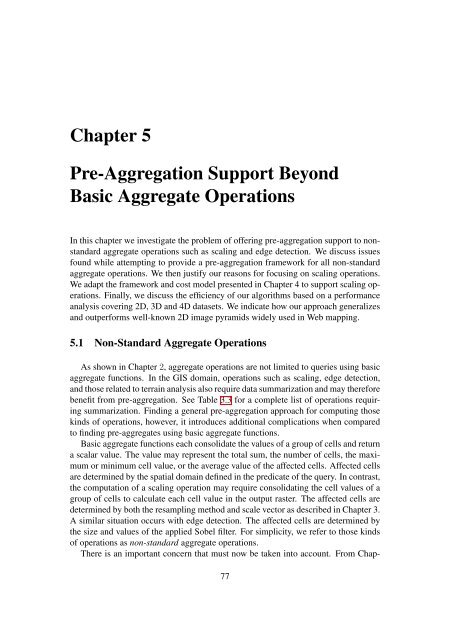Applying OLAP Pre-Aggregation Techniques to ... - Jacobs University
Applying OLAP Pre-Aggregation Techniques to ... - Jacobs University
Applying OLAP Pre-Aggregation Techniques to ... - Jacobs University
You also want an ePaper? Increase the reach of your titles
YUMPU automatically turns print PDFs into web optimized ePapers that Google loves.
Chapter 5<br />
<strong>Pre</strong>-<strong>Aggregation</strong> Support Beyond<br />
Basic Aggregate Operations<br />
In this chapter we investigate the problem of offering pre-aggregation support <strong>to</strong> nonstandard<br />
aggregate operations such as scaling and edge detection. We discuss issues<br />
found while attempting <strong>to</strong> provide a pre-aggregation framework for all non-standard<br />
aggregate operations. We then justify our reasons for focusing on scaling operations.<br />
We adapt the framework and cost model presented in Chapter 4 <strong>to</strong> support scaling operations.<br />
Finally, we discuss the efficiency of our algorithms based on a performance<br />
analysis covering 2D, 3D and 4D datasets. We indicate how our approach generalizes<br />
and outperforms well-known 2D image pyramids widely used in Web mapping.<br />
5.1 Non-Standard Aggregate Operations<br />
As shown in Chapter 2, aggregate operations are not limited <strong>to</strong> queries using basic<br />
aggregate functions. In the GIS domain, operations such as scaling, edge detection,<br />
and those related <strong>to</strong> terrain analysis also require data summarization and may therefore<br />
benefit from pre-aggregation. See Table 3.3 for a complete list of operations requiring<br />
summarization. Finding a general pre-aggregation approach for computing those<br />
kinds of operations, however, it introduces additional complications when compared<br />
<strong>to</strong> finding pre-aggregates using basic aggregate functions.<br />
Basic aggregate functions each consolidate the values of a group of cells and return<br />
a scalar value. The value may represent the <strong>to</strong>tal sum, the number of cells, the maximum<br />
or minimum cell value, or the average value of the affected cells. Affected cells<br />
are determined by the spatial domain defined in the predicate of the query. In contrast,<br />
the computation of a scaling operation may require consolidating the cell values of a<br />
group of cells <strong>to</strong> calculate each cell value in the output raster. The affected cells are<br />
determined by both the resampling method and scale vec<strong>to</strong>r as described in Chapter 3.<br />
A similar situation occurs with edge detection. The affected cells are determined by<br />
the size and values of the applied Sobel filter. For simplicity, we refer <strong>to</strong> those kinds<br />
of operations as non-standard aggregate operations.<br />
There is an important concern that must now be taken in<strong>to</strong> account. From Chap-<br />
77
















